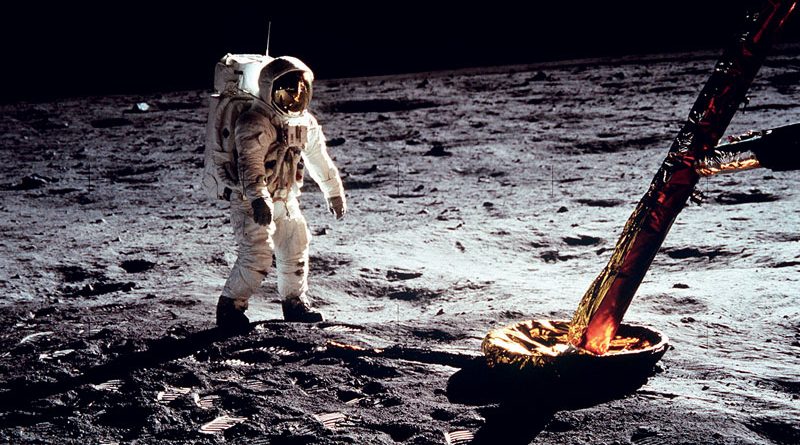Aluminium’s Leading Role in Space Exploration
50 years ago, with the Apollo 11 mission, metallic aluminium arrived on the moon for the first time
by Giuseppe Giordano
Along with the ongoing celebrations of Apollo 11’s trip to the moon and of the first steps taken by a human being on our satellite’s ground, it is worth noting the relevant presence of aluminium alloys among the materials used in all of the project’s components. Aluminium was the main material used in the construction of the LEM (Lunar Excursion Module), that is, the part of the spaceship which landed on the moon. The LEM was part of a spaceship made up by the lunar module (LM), the command module (CM) and a service module (SM), as illustrated in the diagram. The same figure also shows the Saturn V vehicle used for the launch of the spaceship. The ratio in size between the spaceship and the Saturn V propeller rocket is impressive. Particularly, the command module which hosted the three astronauts, about three metres high, represented just over 2% of the height and 0.3% of the weight of the entire launch system.
Aluminium guarantees mechanical resistance at low temperatures
The vehicle is undoubtedly one of the largest machines ever constructed by humans. As high as a 25-storey building (110 metres), with a 10-metre diameter an empty weight of 130 tons and of 3000 tons when fully loaded, it had the theoretical capability of sending into orbit objects weighing up to 140 tons. The engines were so powerful that when they were tested, the vibrations generated in the ground could be felt as much as 150 km away. The Saturn V rocket was made up of about 5.6 million classified parts, many of them being made out of aluminium. The external containing wall and the propeller tanks were made using aluminium alloys. The main factors which determined this choice are, obviously, the metal’s lightness and its machinability compared to titanium or magnesium alloys. Another factor in favour of aluminium alloys lies with the general property of metals with cubic crystalline structure with centred faces to offer stability (or improvement) of tensile properties as temperature decreases and not to suffer from increased fragility even at such cryogenic temperatures as those of liquid oxygen and hydrogen, the propellants used for Saturn V.
The rocket with its eleven engines subdivided in three stadia used up an amount of liquid hydrogen and oxygen equal to about 3.5 million litres, with an initial consumption speed equal to about 15,000 litres per second. Another factor which favoured the use of aluminium for the vehicle was the value of the scrap generated by the launch, which would have been all the more considerable if made up by a single metal. In a project worth billions of dollars, even this aspect was considered, as has been often underlined in the project’s documents.
The vehicle used to carry the astronauts from Earth to the moon’s orbit and back was the command module, made out of two basic structures, the internal pressure shell and the external heat shield inserted one into the other.
The inner structure is an aluminium sandwich construction which consists of a welded aluminium inner skin, adhesively bonded aluminium honeycomb core and outer face sheet. The thickness of the honeycomb varies from about 40 mm at the base to about 20 mm at the forward access tunnel. The outer structure is the heat shield and is made of stainless steel honeycomb brazed between steel alloy face sheets. It varies in thickness from 15 to 70 mm. Part of the area between the inner and outer shell is filled with a layer of fibrous insulation as additional heat protection.
The principal task of the heat shield that forms the outer structure is to protect the crew from the fiery heat of entry (up to 3000 °C) -heat so intense that it melts most metals. The ablative material that does this job is a phenolic epoxy resin. This ablative material controls the rate of heat absorption by charring or melting rapidly. This dissipates the heat and keeps it from reaching the inner structure. The command module enters the atmosphere with its base down; this is covered by the thickest portion of the heat shield.
The outside, but above all the inside of the command module and of the LEM look basic, to say the least. Aluminium panels cover all the inside walls and host dozens of switches and indicator lights. Room for the crew was reduced to the barest essential.
The Lunar Excursion Module
The LEM lunar module was made up of two distinct stadia, one for descent and arrival on the moon’s surface, the other to return to the command module. The LEM had a total mass of about 10,000 kg, with propellant accounting for roughly 80% of this figure. The basic structure was formed by honeycomb aluminium panels wrapped in a plastic polyester film with one side coated in aluminium. The number of film layers was variable, according to the temperatures reached by the various areas of the base. Four “legs” made out of 7xxx alloy served as a support. The final part of the four legs was made out of an aluminium honeycomb to form an element which could be deformed differently depending on the properties of the moon’s surface. These aluminium panels were therefore the first terrestrial objects to touch the moon’s surface.
The inside of the cabin had even more cramped spaces than the command module. The crew did not even have seats; they were fastened in an upright position in front of the tiny triangular windows allowing them to observe the landing on the moon and the bleak view on the Sea of Tranquility.

